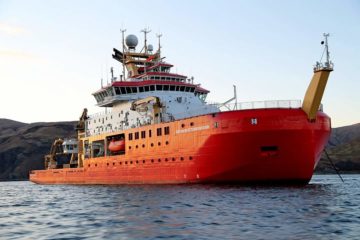In the next decade to century, our ability to predict sea level change is limited by our lack of understanding of critical processes at the boundary between oceans and ice sheets. A new unmanned robotic vehicle will help scientists understand these processes in remote polar locations, by capturing measurements in shallow water and near the ice front.
A high specification autonomous surface vehicle, newly funded by NERC, will enhance observation on RRS Sir David Attenborough (SDA) expeditions. It will increase the scope of the ship to work in shallow and coastal areas, including glacier fronts and calving ice shelves where the ship cannot operate efficiently or safely.

The data from this asset will significantly reduce uncertainty in predictions of global sea level rise for the coming decades, mitigating social, environmental and economic repercussions.
Dr Pierre Dutrieux, an oceanographer at British Antarctic Survey, leads the project. He says:
“This is tremendously exciting for the UK polar community. This new tool will enable us to unlock key mysteries of ice-ocean interactions. It will enable independent, near-simultaneous observation of water column properties and glacier/seabed geometry over the space of a few days.
“The ability to sample these shallow (or deep), near-glacier areas at speed, with high resolution, safely and over prolonged timescales provides a unique and transformative observational capability. The asset will also work as a force multiplier, effectively acting as a ‘second ship’ to carry out routine underway observations in open waters, reducing the carbon footprint of data collection.”
The system will be capable of collecting several essential ocean variables relayed in near-real time via satellite to global databases, and contribute to Southern and Global Ocean Observing Systems (SOOS/GOOS). These observations will be used to improve global climate models and reduce uncertainties in climate projections.
Collaboration with NOC’s Marine Autonomous Research Systems group will further integration of UK’s state-of-the-art facilities, exchanging knowledge in marine and polar autonomous platforms, ensuring cross-pollination of ideas, testing of sensors in various environments, and furthering the UK’s stature in the ultra-competitive domain of robotic autonomy.
Funding is possible from the NERC 2020 Capital Call. The £10.8 million fund will support 11 new capital assets that will support research into fields such as air and water quality and greenhouse gas (GHG) emissions.
Dr Iain Williams, Director of Strategic Partnerships at NERC, said:
“Keeping pace with the latest opportunities afforded by developments in research infrastructure is essential to generate cutting-edge research, improve our knowledge of the global environment and provide solutions to environmental challenges.
This funding will help UK researchers study and tackle major issues such as the impacts of climate change and pollution of our air and water.
These investments, across the UK, will help safeguard the community’s ability to carry out exceptional science, maintaining the UK’s position as a leader in environmental research and innovation.”
About the NERC 2020 Capital Call
This funding opportunity was partly supported by the recent £213m investment from the government’s World Class Labs funding scheme, received via UKRI.
The recently published Natural Environment Research Council (NERC) Responsible Business Statement and UKRI Environmental Sustainability Strategy demonstrate the strategic importance of delivering environmental science in ways that are environmentally, economically and socially sustainable.
The NERC Strategic Capital Call 2020 has led the way in delivering the sustainability strategy by being the first NERC funding opportunity to integrate sustainability as an independent assessment criterion.